Choosing a pond pump
The article gives you some information on Choosing a pond pump. One of the most common mistakes that I see when people are planning a pond is that they choose a pond pump that is the incorrect size or type for the job. The result is that they have a water feature that does not meet their expectations with a pump that requires regular cleaning, in some cases even daily for it to function properly. Like so many things in life, this can be prevented with a little planning.

The first point to consider when choosing a pond pump is to know exactly what you want the pump to do. Does it need to run a waterfall or deliver water to a filter? Do you just want a fountain in the middle of a pond or to have water coming out from a statue?
Once you have decided what you want the pump to do, before you race out and buy it there are a couple of other factors to consider. How many litres are in your pond and how high and far does the water need to travel from the pond. The amount of water in a pond is especially important if you want to use the pump to run a filter or Ultra Violet Clarifier to control algae as the total volume of water in the pond needs to travel through the filter about 1 1/2 to 2 times per hour. If you had a 2000 litre pond with a filter system, you would require a pump that moved a minimum of 4000 litres per hour to run it.
All pumps have what is known as the ‘head maximum’, which is the height at which the pump can no longer lift water. Remember that as the height increases, the flow decreases. For example a pump that can move 2000 litres per hour at ground level, may have a flow of 1000 litres per hour at 1mtr, 400 litres per hour at 1.5 metres and a head max of 2 metres. If you had a waterfall that was 1.8 metres higher than the pond, you would need a pump larger than this to ensure adequate flow.
When you are setting up the pump, always use the largest size hose that you can as the flow rate on a pump can be lost when a hose of a small diameter is used due to friction from the water flowing through the pipe.
When looking at pumps pay particular attention to how the water is drawn into the unit. Many pumps feature small sponges called a pre-filter that water is drawn through before being pumped. These types of pumps are better suited to water features that contain no fish or plants as the sponge can clog quickly and require regular cleaning. If you have a pond with fish and plants, look for one of the models that doesn’t have a pre-filter as these will function for much longer periods without maintenance. Some models may need cleaning once or twice a year
Finally, choose a pump slightly bigger than you require as some flow rate will be lost in between cleaning the unit out and you can always reduce the flow on a large pump, but you can’t increase the flow of a pump that is too small.



